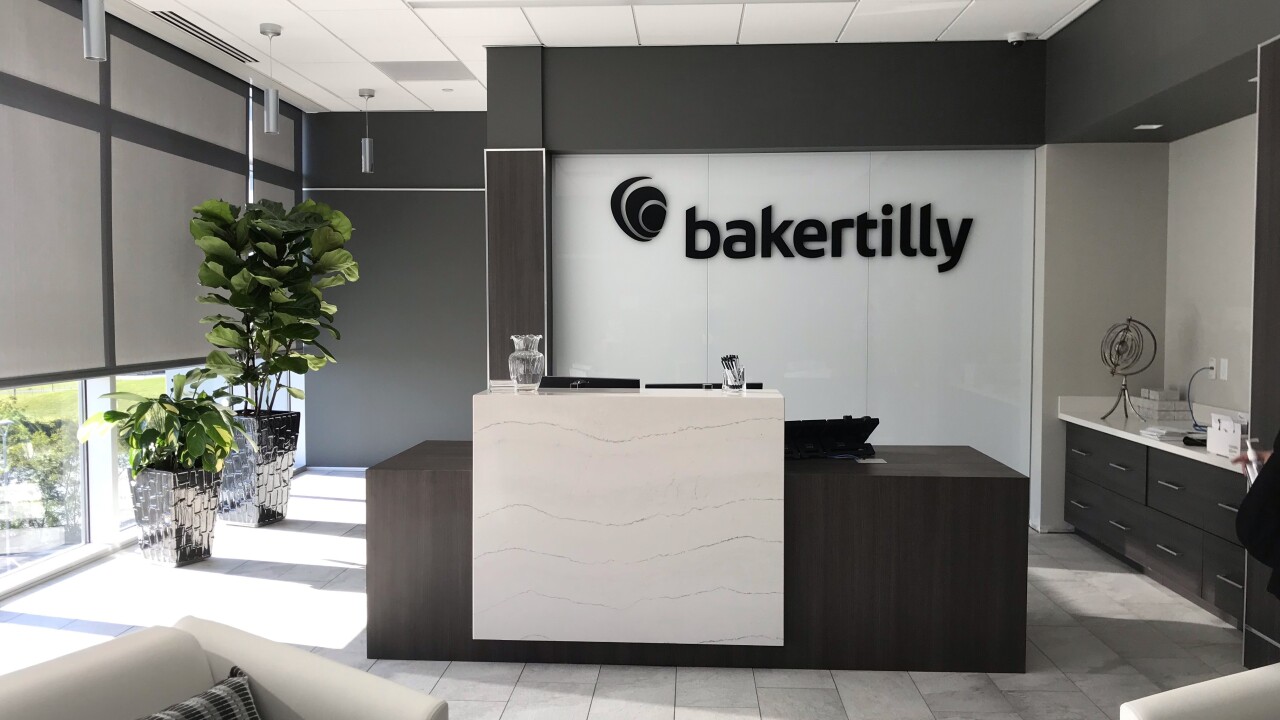Digital systems have breakpoints just like paper-based systems. Over the past 10 years, the requirements and capabilities of firm systems have changed, yet processes and people often have not made the necessary adjustments to leverage the available technology.With technology advancements always on the horizon and Microsoft's release of a new operating system and upgrade to Office 2007, firms should think about where they are today and where they want to be within three years.
This may sound rather simple, but in practice it requires careful planning, dedicated people and documented processes. Neglecting any of the three "Ps" will constrain your firm's growth. What got you to this point won't necessarily guarantee success in the future.
Common breakpoints in firm systems are:
* A communication breakdown between firm management and technology professionals.
* No documented vision or growth plan.
* Getting data from the client into the firm's systems.
* Transfer of data from one application to another.
* Tracking workflow.
* Review of work in a digital world.
* Storage of dynamic and static data in a secure environment.
* Presentation of finished products to clients and authorities.
* A workforce with weak technology skills.
* Adequate resources.
Let's review each of these areas in some detail and develop an overall strategy to improve a firm's systems.
* Communication breakdowns. This is a decades-old problem that does not hold much hope for improvement in the majority of firms. Information technology professionals understand technology, but they often don't comprehend the firm's vision and mission. On the other side, firm management often does not perceive the enormous capabilities of technology and improved processes.
Firms must bridge this gap between personnel in order to succeed in the future. Today's chief information officer must possess technology skills, but even more important are communication, business savvy, marketing, project management and personnel skills. The CIO should be part of the management team. Even the largest firms have difficulty filling this position with the right skillset.
* Vision and written plan. Sadly, the majority of U.S. firms don't have a strategic plan, and of those that do, a large percentage neglect to share it with employees. A technology plan should integrate with the firm's vision and strategic plan. The first step is to document the firm's strategic plan and then integrate a technology plan. This can be accomplished in less than a week if firms make it a priority and utilize a knowledgeable and experienced facilitator.
* Getting client data into the firm's system. One of the biggest challenges is to accelerate the movement of client data into a format that integrates with workpaper software, and tax and financial statement preparation applications. Some clients have multiple systems for both paper and digital documents.
According to Jack Welch in his book, Straight from the Gut, "Digitization is the holy grail of overhead reduction." According to Welch, John Chambers of Cisco once recommended that GE completely shut down its paper-based workflow. Until it did, most workers still relied on paper, and unfortunately this example illustrates the scenario within a majority of accounting firms. Try removing printers and copies altogether - doing so will force everyone to work digitally.
* Transferring client data among firm applications. Many firms have not spent enough time planning these three core applications (workpaper, tax preparation and financial reporting). It is not uncommon for a tax or audit department to select software without considering integration, database structure and file formats. These core applications produce dynamic results, so version control and check in/out capabilities are essential.
Another common mistake is to rely on Microsoft Office - Word and Excel - for producing financial statements. (This is an easily manipulated advancement beyond paper - not a reporting system.) Capturing the big picture and how tech- nologies integrate is critical. Firms should think about digital systems, rather than applications and paper-based processes.
* Tracking workflow. Workflow is the most significant byproduct from sourcing in India. On my first visit there in 2001, I made careful observation of the strategy that Indian sourcing companies were employing. Upon questioning, they readily admitted that they had been involved in developing systems for companies like FedEx, UPS, Charles Schwab and others in the Fortune 500.
If FedEx can track a package around the world, firms should be able to track projects with good systems, discipline and training. Today, workflow and project management systems are available from leading vendors. Key to this strategy is integration with a firm's practice management system. Databases must be interactive in order for firms to receive the greatest benefit.
Indians also utilize Six Sigma, driving out process errors at the lowest possible level. Many firms rely upon highly paid partners to drive out errors during the review process. A good workflow system requires thinking, change management, discipline and egos left at the door.
* Reviewing work in digital format. This strategy requires change, and many in the accounting profession still resist on-screen reviews of tax returns and financial reporting. While most accountants today use two or three monitors, others still insist upon paper in the review process.
By allowing paper in a digital system, firms dilute the return on investment and leave weak links in the workflow chain. Sadly, these weak links are often partners with political power. In many firms, these weak links are ignored, and the rest of the team tries to work around them. (At GE, Jack Welch could take care of the problem.) Firms should consider both the Six Sigma approach (drive errors out early in the process) and digitize the entire workflow process.
* Data storage. Secure data storage is now a critical initiative for most firms - with good reason. Should a firm source its data storage, or should it control data internally? Either way, managing data is a significant challenge.
Federal and state regulations abound regarding data retention and destruction. The Sedona Guidelines (and now the Federal Rules of Civil Procedure, effective Dec. 1, 2006) impact any firm, regardless of its size. According to surveys conducted at major conferences in 2006 and 2007, a majority of partners were unaware of these guidelines, and often believed that their firms were exempt.
In addition, some partners constitute a high risk to the firm because they regularly ignore its policies. Firms must document standards, policies and procedures regarding the retention and destruction of data - and they must be enforced uniformly throughout the firm.
* Presentation of final products. E-mail has become a mission-critical tool for accounting firms, and it is not uncommon to e-mail sensitive client information. Many states are issuing guidelines that prohibit using e-mail to deliver sensitive client data. A much better strategy is to use portals. They are secure and offer clients round-the-clock access to tax returns, financial statements and other important documents.
Firms that furnish a portal for a client will almost always emerge as that client's primary advisor. Trusted advisor status is important, but the primary advisor has an inside track on future fees and expanded relationships. It's what you don't know that can often cost you money and the loss of clients. Banks, financial planners and insurance providers are all making significant investments in portals.
* A workforce with weak technology skills. According to the Gartner Group, every hour an employee spends in training results in five hours of increased capacity. Retention and attraction of employees is the No. 1 danger to the accounting industry. Seniority is a thing of the past. Firms that provide innovative training, issue state-of-the-art technology and offer flexible work arrangements will win the competition for talent. Moreover, most workers no longer expect a lifetime guarantee of employment. Instead, they prefer to regularly master new skills that keep them competitive in the job market.
Partners are not exempt.
People with weak technology skills negatively impact production in a results-based economy, because they don't get as much done. However, they may increase revenues in an effort-based economy (in the short view) because they can charge more for the job (since they have to spend more time). But clients perceive value in results, not in effort. Firms should change to focus on technical (traditional CPE), soft and technology skills as they develop a training/learning culture.
* Resources. Accounting firms have never been known for investing too much in technology (hardware, software or training). Technology's definition has now evolved to include anything that plugs into the wall (telephone systems, document management and bandwidth).
The best firms spend 6 to 7 percent of revenues on technology, and employ one technology specialist for every 25 end-users. The ratio of technology specialists to end users is high in the accounting industry because of the number of supported applications, the lack of integrated systems and the level of technology expertise in the profession.
FOLLOW THROUGH
A digital makeover requires the allocation of significant resources, but a firm's return on this investment is even more significant. Attitude represents the biggest difference between firms that excel and those that struggle. It is easy to fulfill your own prophecy. If you believe a system will fail, it generally does. If you commit and believe that a digital transformation can succeed, it will.
Change is difficult, and what you understood about technology three years ago may no longer be relevant. But the rewards offered by a digital environment where employees can work from anywhere at any time are enormous.
In conclusion, note that I did not focus on hardware, software or vendors. The most critical breakpoints involve people, planning and processes. Leadership must provide vision. Management must secure accountability. And employees must provide effort and a good attitude to ensure success.
Gary Boomer, CPA, is the president of Boomer Consulting in Manhattan, Kan.





